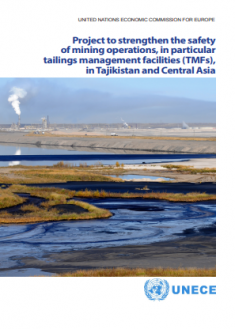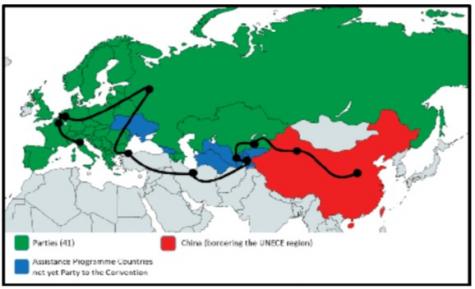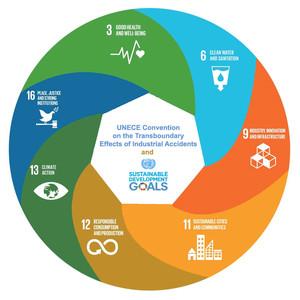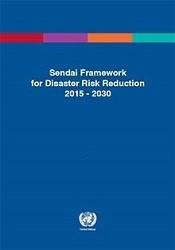UNECE Project to strengthen the safety of mining operations, in particular tailings management facilities (TMFs), in Tajikistan and Central Asia.
Introduction

During the period of 2019-2021, UNECE implemented the Project to strengthen the safety of mining operations, in particular tailings management facilities (TMFs), in Tajikistan and Central Asia, thanks to financial support from the Swiss Federal Office for the Environment. The Project was carried out under the auspices of the UNECE Convention on the Transboundary Effects of Industrial Accidents (Industrial Accidents Convention).
Leaflet on the Project to strengthen the safety of mining operations, in particular TMFs, in Tajikistan and Central Asia (English, Russian)
The Project was built on UNECE’s experience in the area of tailings safety, including:
- UNECE Pilot project to strengthen the safety of mining operations, in particular TMFs, in Kazakhstan and beyond in Central Asia, financed by the Swiss Federal Office for the Environment
- Activities of the UNECE Joint Expert Group on Water and Industrial Accidents (under the Industrial Accidents Convention and the Convention on the Protection and Use of Transboundary Watercourses and International Lakes (Water Convention))
- UNECE Safety guidelines and good industry practices for tailings management facilities (English, Russian) and a related checklist methodology developed under the leadership of the German Federal Environment Agency
- Project on Improving the Safety of Tailings Management Facilities in the Caucasian Region, Project on Improving the Safety of Industrial TMFs, based on the example of Ukrainian Facilities, and Project on Raising Knowledge among Students and Teachers on Tailings Safety and its Legislative Review in Ukraine, implemented under the leadership of the German Environment Agency under the workplan of the UNECE Industrial Accidents Convention.
UNECE worked in close cooperation with the relevant national authorities of Tajikistan and in partnership with other relevant international and regional organizations and NGOs in the Project’s implementation.
Project Objectives
The general objective of the project was to strengthen the safety of TMFs in Tajikistan and Central Asia. In particular, the project aimed to achieve the following:
- Enhance the capacity of Tajikistan to reduce water-related risks by improving the management of TMFs, including with regard to control measures to prevent the release and ensure the environmentally sound management of mercury
- Improve institutional coordination among the respective national authorities regarding TMF safety and industrial accident prevention, preparedness and response
- Support Tajik competent authorities in identifying and rating TMFs with regard to the hazard they pose for human health and the environment, with a focus on TMFs likely to cause transboundary pollution
- Support Tajik competent authorities and operators in improving the safety of TMFs through identifying short-, medium- and long-term measures to address safety deficiencies in TMFs
- Strengthen the implementation of the UNECE Industrial Accidents and Water Conventions to enhance water management and to reduce related risks
- Strengthen countries’ knowledge about international Conventions in the field of chemicals and waste management, including on the relevance of ratification and implementation of those Conventions by Tajikistan for an improved management of mining tailings, and on the relevant guidance materials
- Share experiences and lessons learned on TMF safety, particularly with regard to preventing the release and improving the environmentally sound management of mercury, with the other Central Asia countries.
Project Beneficiaries
The main beneficiary of the project was Tajikistan and its competent authorities and operators. The project was implemented in close cooperation with the national competent authority in the area of preventing accidental water pollution from TMF accidents in Tajikistan, notably:
- Service of the State Supervision over the Safe Conduct of Work in Industry and Mining Supervision under the Government of the Republic of Tajikistan
- Committee on Emergency Situations and Civil Defence under the Government of the Republic of Tajikistan, and
- Ministry of Energy and Water Resources of the Republic of Tajikistan
The project was implemented in close cooperation with other relevant authorities, e.g. at the local level, and industry representatives. Representatives from Kazakhstan, Kyrgyzstan, Turkmenistan and Uzbekistan also benefited from the project and were invited to specific activities, notably to the subregional workshop in autumn 2019.
Project Activities
The key activities of the project were:
- Inception event on the project launch (Kokshetau, Kazakhstan, 11-13 June 2019)
- Preparation of the hazard rating list and map for TMFs in Tajikistan, including TMFs that could cause transboundary pollution
- Subregional workshop to present and disseminate the project results, share lessons learned and exchange experiences, with the participation of other countries from Central Asia
- On-site training, resulting in the development of the specific short-, medium- and long-term measures to address safety deficiencies in the TMF. The on-site training was redesigned into 3 components in order to address challenges in view of coronavirus pandemic. Specifically, the event consisted of: 1) technical meeting (online, 23 April 2021); 2) on-site training (Penjikent, Tajikistan 2-4 June 2021) and 3) evaluation workshop (online, 3 June 2021).
- Report from the onsite training (Penjikent, Tajikistan, 2-4 June 2021) and results of the application of the tailings management facilities (TMF) Methodology, based on the safety evaluation of the TMF of JV «Zarafshon» (Penjikent, Republic of Tajikistan), available in English and Russian
The project supported Tajikistan in implementing the recommendations arising from the 3rd UNECE Environmental Performance Reviews (EPRs), in particular, to (a) strengthen its approach to risk management of hazardous/tailings facilities, including through improving national coordinating and implementing joint national inspections (recommendation 15.3), and to (b) strengthen capacities to accede to the UNECE Industrial Accidents and Water Conventions (recommendations 6.6 and 15.5). Experts from the two Conventions’ Joint Expert Group on Water and Industrial Accidents supported the project implementation. Some project activities were implemented back-to-back with the UNECE pilot project to strengthen the safety of mining/tailings safety in Kazakhstan, to take advantage of existing synergies.
Expected Results
The following results were achieved:
- Improved institutional structures and cooperation mechanisms between authorities at the national and local levels, and between authorities and the industry in Tajikistan.
- Enhanced levels of TMF safety and the sound management of chemicals in Tajikistan and Central Asia.
- Increased awareness and level of implementation of international legal instruments, notably of the UNECE Industrial Accidents and Water Conventions and the Minamata Convention on Mercury.
- Reduced risks of TMF failures for Tajikistan and other Central Asian countries participating in the Belt and Road Initiative.
- Improved transboundary cooperation between the countries in Central Asia related to the prevention of water pollution from TMFs accidents.
Why was the project needed?
Tajikistan, along with other Central Asian countries, relies heavily on economic activities that produce, process or use hazardous substances in large quantities. Such activities encompass the extraction and processing of minerals and metals, such as gold, mercury and uranium.
The main risks related to TMFs in Tajikistan are:
- Abandoned, improperly handled or orphaned TMFs, storing enormous quantities of hazardous substances
- Release of mercury or other heavy metals and hazardous substances, leading to soil pollution due to the formation of acid mine drainage
- Groundwater contamination and ecosystem damage caused by the degradation of tailings
- Accidental water pollution, due to the leakage or failure of TMFs, affecting drinking water quality and quantity, and leading to severe transboundary impacts
Improving the safety of the TMFs and strengthening the prevention of water pollution are crucial for Tajikistan, in the light of major infrastructure initiatives such as the Belt and Road Initiative and future envisaged developments, including in the mining sector.

Linkages with the Belt and Road Initiative and the 2030 Agenda for Sustainable Development
The project aimed to reduce the risks by Tajikistan and other Central Asian countries participating in the Belt and Road Initiative (BRI). The UNECE Safety Guidelines and Good Practices for TMFs and the related TMF methodology helped to identify hot spots in the regions and subsequently improve the management of these facilities. The lessons learned and shared will also improved the design, construction, and management of TMFs in the future going forward, streamlined cooperation and increased disaster preparedness, reducing risk to all BRI participating countries. BRI passes through at least 16 UNECE countries that are Parties to the Industrial Accidents Convention or beneficiaries of the Assistance and Cooperation Programme, including the countries in Central Asia.

The project supported the beneficiaries in their implementation of the Sendai Framework for Disaster Risk Reduction for 2015-2030 and the Sustainable Development Goals, in particular Goal 6 and target 6.3: to improve water quality by 2030, by minimizing the release of hazardous chemicals and materials, and Goal 9 to build resilient infrastructure, promote inclusive and sustainable industrialization and foster innovation.

Furthermore, the implementation of this project contributed to achieving the objectives and four priorities of the Sendai Framework for Disaster Risk Reduction for 2015-2030, namely to
1) enhance the understanding of disaster risk,
2) strengthen disaster risk governance,
3) invest in disaster risk reduction for resilience and
4) enhance disaster preparedness.